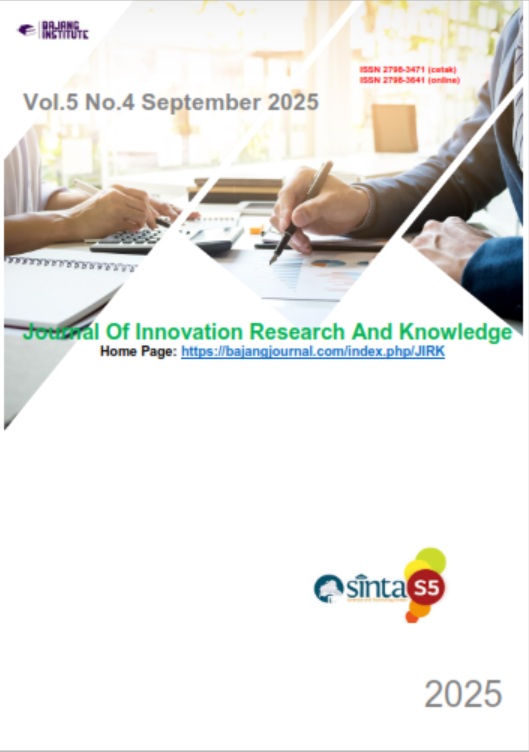OPTIMALISASI SUMBER DAYA MANUSIA DAN SARANA PRASARANA UNTUK PENINGKATAN MUTU PELAYANAN KIA DI KABUPATEN POSO
DOI:
https://doi.org/10.53625/jirk.v5i4.11283Keywords:
Human resources, infrastructure, MCH service qualityAbstract
Maternal and child health (MCH) is a key indicator of public health development. Poso Regency continues to face challenges related to the limited and uneven distribution of health workers, as well as inadequate infrastructure for MCH services. This study aims to analyze the conditions of human resources (HR) and infrastructure, examine their relationship with service quality, and formulate optimization strategies for MCH services in Poso. This operational qualitative research involved 31 informants, including health office officials, primary health center heads, midwives, MCH program coordinators, cadres, and patients. Data were collected through in-depth interviews, focus group discussions (FGDs), and observations, and analyzed using Miles & Huberman’s interactive model. The findings revealed that shortages and unequal distribution of health workers, combined with limited infrastructure (such as the absence of ultrasound machines, incubators, and maternal-child ambulances), significantly reduced the quality of MCH services. The proposed optimization strategies include continuous training for health workers, redistribution of staff based on workload, provision of essential medical equipment, strengthening health cadres, and cross-sectoral coordination. This study highlights the importance of an integrated approach combining HR and infrastructure to enhance the quality of MCH services in Poso Regency.
References
Erlindawati, E., Lubis, R., & Musnadi, S. (2022). The effect of quality of maternal and child health services on health system performance. Prosiding Seminar Nasional Universitas Muhammadiyah Semarang, 1–8.
Fidorova, S., & Febriani, R. (2023). Peran kader kesehatan dalam peningkatan mutu layanan KIA di wilayah perdesaan. Jurnal Kesehatan Masyarakat Indonesia, 18(2), 145–154.
Hardati, R., Arifien, M., & Putri, A. (2018). Pola sebaran fasilitas kesehatan di Indonesia dan keterjangkauannya. Jurnal Geografi, 10(1), 1–12. https://doi.org/10.xxxx/jgeo.2018.10.1
Navis, M., Roflin, E., & Rahmawati, D. (2019). Determinants of service quality and patient satisfaction in maternal and child health services. Jurnal Administrasi Kesehatan Indonesia, 7(2), 90–100.
Parasuraman, A., Zeithaml, V. A., & Berry, L. L. (1994). SERVQUAL: A multiple-item scale for measuring consumer perceptions of service quality. Journal of Retailing, 64(1), 12–40.
Romadhona, R., & Siregar, A. (2018). Analisis sebaran tenaga kesehatan Puskesmas di Indonesia. Jurnal Kesehatan Manarang, 4(2), 104–112. https://doi.org/10.xxxx/jkm.2018.4.2
Rosita, D., & Tinexcelly, R. (2021). Penyelenggaraan pelayanan KIA di Puskesmas terpencil pada masa pandemi. Jurnal Kajian dan Pengembangan Kesehatan Masyarakat, 1(2), 75–84.
Sarnia, M., Manaf, A., & Mahmud, R. (2022). Pengaruh beban kerja tenaga kesehatan dan fasilitas terhadap peningkatan kualitas pelayanan kesehatan. Administratio, 11(1), 33–47. https://doi.org/10.xxxx/administratio.2022.11.1
Sihotang, L., Putri, Y., & Manurung, D. (2025). Hubungan mutu pelayanan KIA dengan kepuasan ibu bersalin di Puskesmas. Jurnal Kebidanan Nusantara, 14(1), 22–31.
UNICEF Indonesia. (2023). Breastfeeding and child survival report. Jakarta: United Nations Children’s Fund.
UNFPA Indonesia. (2022). Maternal mortality in Indonesia: Trends and challenges. Jakarta: United Nations Population Fund.
WHO. (2010). Monitoring the building blocks of health systems: A handbook of indicators and their measurement strategies. Geneva: World Health Organization.
WHO. (2024). Maternal mortality fact sheet. Geneva: World Health Organization.













